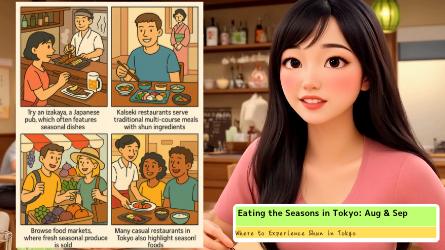Welcome to Tokyo.
Today, I’d like to take you on a journey into one of Japan’s most unique food traditions — the concept of shun, or seasonality.
What does “shun” mean? Why do Japanese people value it so deeply? And, as summer fades into autumn, what kinds of seasonal flavors can you experience right here in Tokyo between late August and September?
Let’s explore together.
Japan’s Four Seasons and the Culture of Shun

Japan is an island nation, stretching long from north to south and surrounded by the sea. Because of this geography, the country experiences a rich variety of climates.
The year is divided into four distinct seasons: spring, summer, autumn, and winter. Of course, many countries also speak of “four seasons.” But in Japan, the seasons are felt and celebrated in everyday life in a very unique way.
In spring, cherry blossoms bloom and mountain vegetables sprout. In summer, fireworks light up the sky while people enjoy watermelon and shaved ice. In autumn, leaves turn red and golden, and dishes made with mushrooms, chestnuts, and persimmons fill the table. In winter, snow falls and families gather around hot pots.
This deep connection between the natural seasons and the food on the table is what makes Japanese culture special.
And at the heart of this connection lies the concept of shun — the moment when an ingredient is at its peak of flavor, nutrition, and affordability.
For centuries, Japanese people have believed that eating in harmony with the seasons is the best way to enjoy both health and taste.
Understanding Shun in Japanese Food

In Japan, people often say: “To taste shun is to taste the season itself.”
Even the same fish can taste completely different depending on the time of year. For example, bonito, known as katsuo in Japanese, is light and refreshing in spring, but in autumn it becomes rich and fatty, almost melting in the mouth.
Vegetables follow the same rhythm. Summer cucumbers are cooling and hydrating, while autumn mushrooms and winter radishes warm the body. It feels almost as if nature itself is guiding human health through food.
This respect for seasonal balance is one of the foundations of Japanese cuisine, or washoku. In fact, when UNESCO recognized washoku as an Intangible Cultural Heritage in 2013, one of the key reasons was its emphasis on seasonality and harmony with nature.
So, to understand Japanese food, one must understand shun.
Seasonal Delights of Late August and September

Now, let’s take a closer look at what you can enjoy in Tokyo during late August and September.
Fish and Seafood
The most famous autumn fish is sanma, or Pacific saury. When grilled with just a sprinkle of salt, its rich aroma fills the air and its juicy fat drips into the fire. Many izakaya pubs and casual restaurants in Tokyo serve grilled sanma at this time of year.
Another highlight is bonito, or katsuo. While spring bonito is light, the autumn “returning bonito” is fatty and full-bodied. You can try it as sashimi or sushi in many Tokyo restaurants.
And though it is better known in Kyoto, pike conger eel, or hamo, also appears on menus in high-end Tokyo restaurants around this time, often served in tempura or hot pot dishes.
Vegetables
Eggplant, especially in early autumn, is tender and sweet. Dishes like grilled eggplant or eggplant simmered in broth highlight its flavor.
Pumpkin and sweet potatoes become popular too, not only in savory dishes like stews and tempura, but also in autumn desserts.
And of course, mushrooms such as shiitake and maitake are widely available. For the lucky ones, there is matsutake, the prized and aromatic mushroom that symbolizes Japanese autumn.
Fruits
Japan’s seasonal fruits are especially celebrated.
Grapes such as Kyoho and Shine Muscat are juicy and sweet, and can be found in department stores and fruit shops across Tokyo.
Nashi pears, crisp and refreshing, are perfect for the lingering summer heat.
And figs, with their elegant sweetness, appear in traditional Japanese sweets and modern desserts alike.
Where to Experience Shun in Tokyo

So, where can you actually experience these seasonal flavors while visiting Tokyo?
One option is izakaya pubs and sushi restaurants. Many of them update their menus with seasonal fish, and you’ll often see a section called “Today’s Recommendations,” which usually features ingredients at their seasonal peak.
Another must-visit is the department store food halls, known in Japanese as depachika. Found in places like Shinjuku Isetan or Nihombashi Mitsukoshi, these basements are filled with beautifully presented seasonal fruits, sweets, and ready-to-eat meals. Limited-edition autumn desserts — chestnut cakes, grape-filled mochi, or pear jellies — are especially popular.
Traditional Japanese confectionery shops, or wagashi-ya, also highlight the season. In autumn, you’ll find sweets like chestnut paste called kuri kinton or grape-filled rice cakes called budō daifuku. These are not only delicious but also visually stunning, making them perfect for photos.
And don’t forget Tokyo’s autumn festivals. Local shrines often host celebrations in September, where food stalls line the streets. Here, you might find grilled sanma, sweet potato snacks, or other autumn treats, all in a lively, community atmosphere. Experiencing both the food and the cultural setting together makes it unforgettable.
Shun as a Window into Japanese Culture

Eating seasonal food is more than just enjoying good taste — it is a way to connect with culture.
Through shun, you can feel the rhythm of Japanese life, the way people live in harmony with nature, and how they have done so for centuries.
For visitors, experiencing shun transforms a simple trip into something much deeper, something that stays in the heart long after you return home.
Ending

So, this is the story of Japan’s four seasons, the culture of shun, and the flavors you can enjoy in Tokyo from late August to September.
Remember, eating is also a way of traveling. To taste seasonal food is to experience the country itself.
In Japan, food is not only about nourishment, but also about celebrating time, nature, and tradition.
When you visit Tokyo, don’t just see the sights — savor the seasons.
May your journey here be richer, more meaningful, and of course, more delicious.

